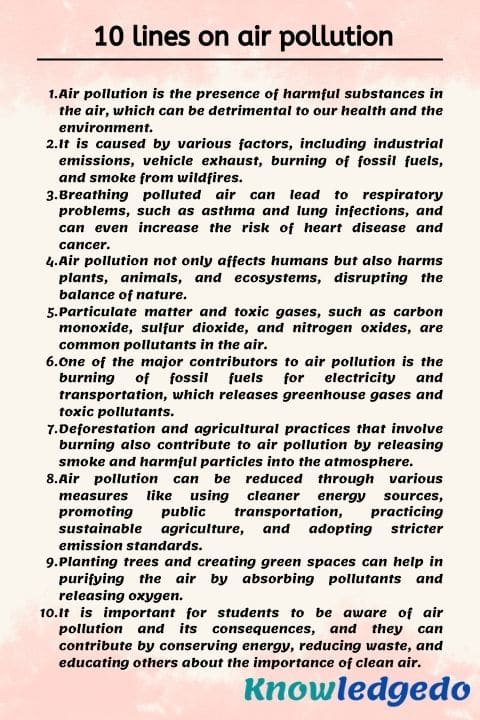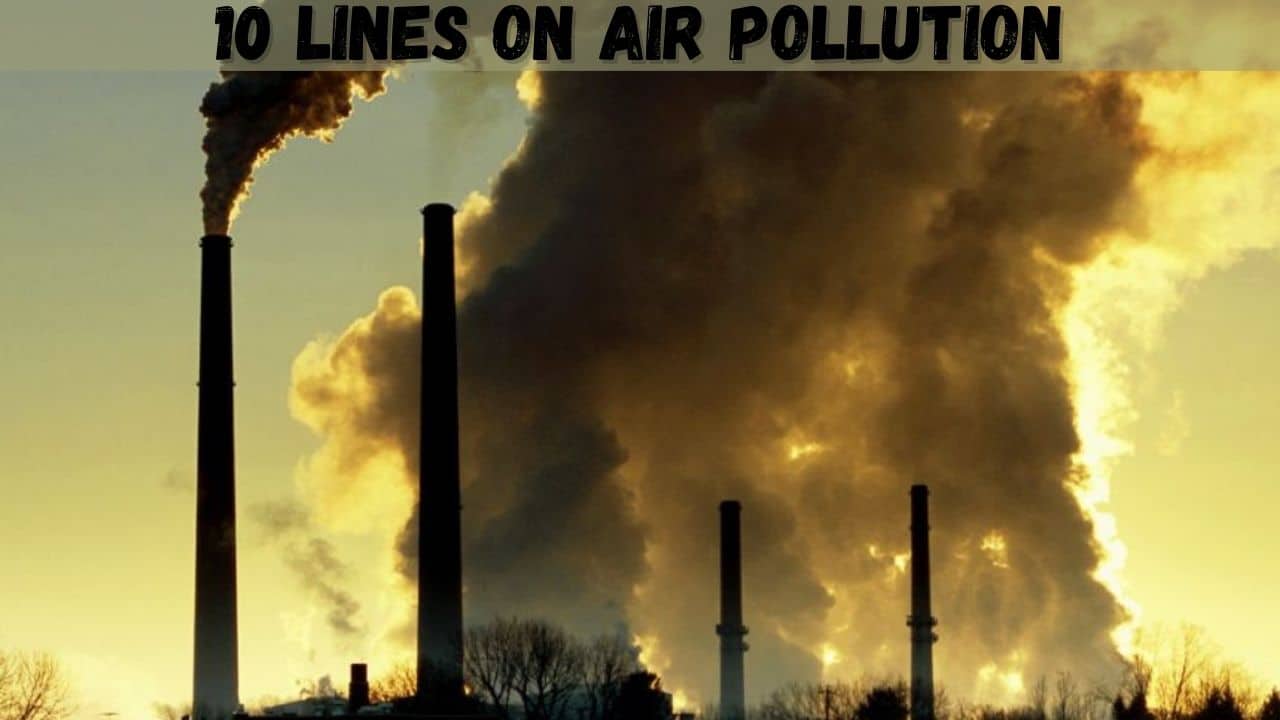Today, we are sharing 10 lines on air pollution in English. This article can help students who are looking for information about 10 lines on air pollution. This Lines is very simple and easy to remember. The level of these Lines is moderate so any student can write on this topic.
This article is generally useful for class 1,class 2,class 3,class 4,class 5,class 6,class 7,class 8,class 9,class 10,class 11,class 12
10 lines on air pollution
1) Air pollution is the presence of harmful substances in the air, which can be detrimental to our health and the environment.
2) It is caused by various factors, including industrial emissions, vehicle exhaust, burning of fossil fuels, and smoke from wildfires.
3) Breathing polluted air can lead to respiratory problems, such as asthma and lung infections, and can even increase the risk of heart disease and cancer.
4) Air pollution not only affects humans but also harms plants, animals, and ecosystems, disrupting the balance of nature.
5) Particulate matter and toxic gases, such as carbon monoxide, sulfur dioxide, and nitrogen oxides, are common pollutants in the air.
6) One of the major contributors to air pollution is the burning of fossil fuels for electricity and transportation, which releases greenhouse gases and toxic pollutants.
7) Deforestation and agricultural practices that involve burning also contribute to air pollution by releasing smoke and harmful particles into the atmosphere.
8) Air pollution can be reduced through various measures like using cleaner energy sources, promoting public transportation, practising sustainable agriculture, and adopting stricter emission standards.
9) Planting trees and creating green spaces can help in purifying the air by absorbing pollutants and releasing oxygen.
10) It is important for students to be aware of air pollution and its consequences, and they can contribute by conserving energy, reducing waste, and educating others about the importance of clean air.

5 lines on air pollution
1) Air pollution refers to the presence of harmful substances in the air that can negatively impact our health and the environment.
2) Common sources of air pollution include industrial emissions, vehicle exhaust, and burning of fossil fuels.
3) Breathing polluted air can lead to respiratory issues, allergies, and other health problems.
4) Air pollution also harms plants, animals, and ecosystems, disrupting the balance of nature.
5) It is important for students to learn about air pollution, its causes, and the actions they can take to reduce it, such as conserving energy and promoting clean transportation.
FAQ
Answer: Air pollution is primarily caused by human activities, such as industrial emissions, vehicle exhaust, burning of fossil fuels, and agricultural practices. Natural sources, like volcanic eruptions and dust storms, can also contribute to air pollution.
Answer: Air pollution can have significant health effects. Breathing in polluted air can lead to respiratory problems, such as asthma and bronchitis. It can also increase the risk of heart disease, lung cancer, and other respiratory illnesses. Children, the elderly, and individuals with pre-existing health conditions are particularly vulnerable.
Answer: Air pollution has detrimental effects on the environment. It can harm plants and reduce crop yields. It can also harm animals, especially those that rely on clean air for survival, such as birds and insects. Additionally, air pollution contributes to climate change by releasing greenhouse gases into the atmosphere.
Answer: Students can play a vital role in reducing air pollution. They can promote sustainable transportation options like walking, cycling, or using public transportation instead of private vehicles. Conserving energy by turning off lights and appliances when not in use, and encouraging others to do the same, can also make a difference. Supporting initiatives that promote clean energy sources and raising awareness about the importance of clean air are additional ways students can contribute to reducing air pollution.
